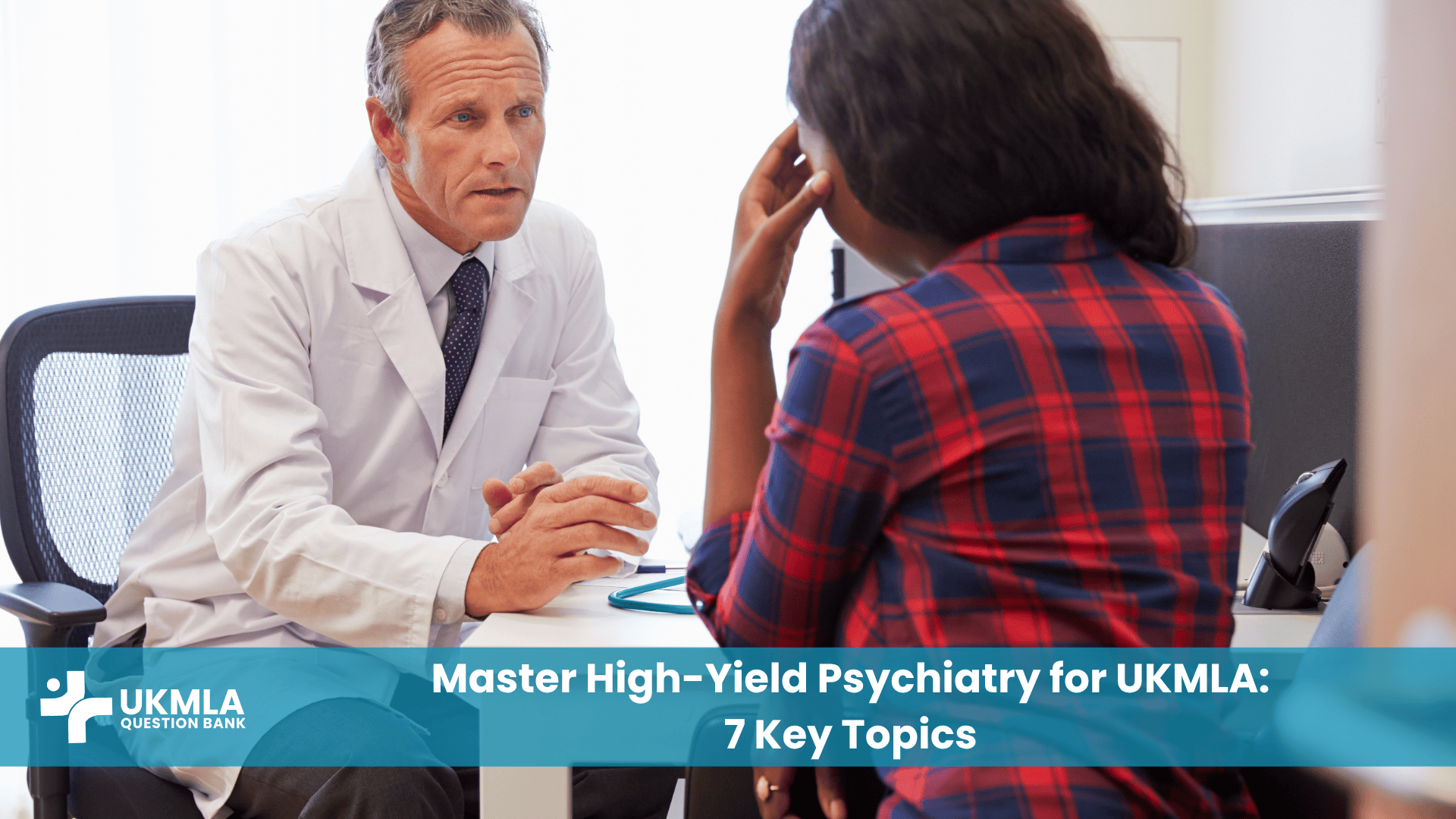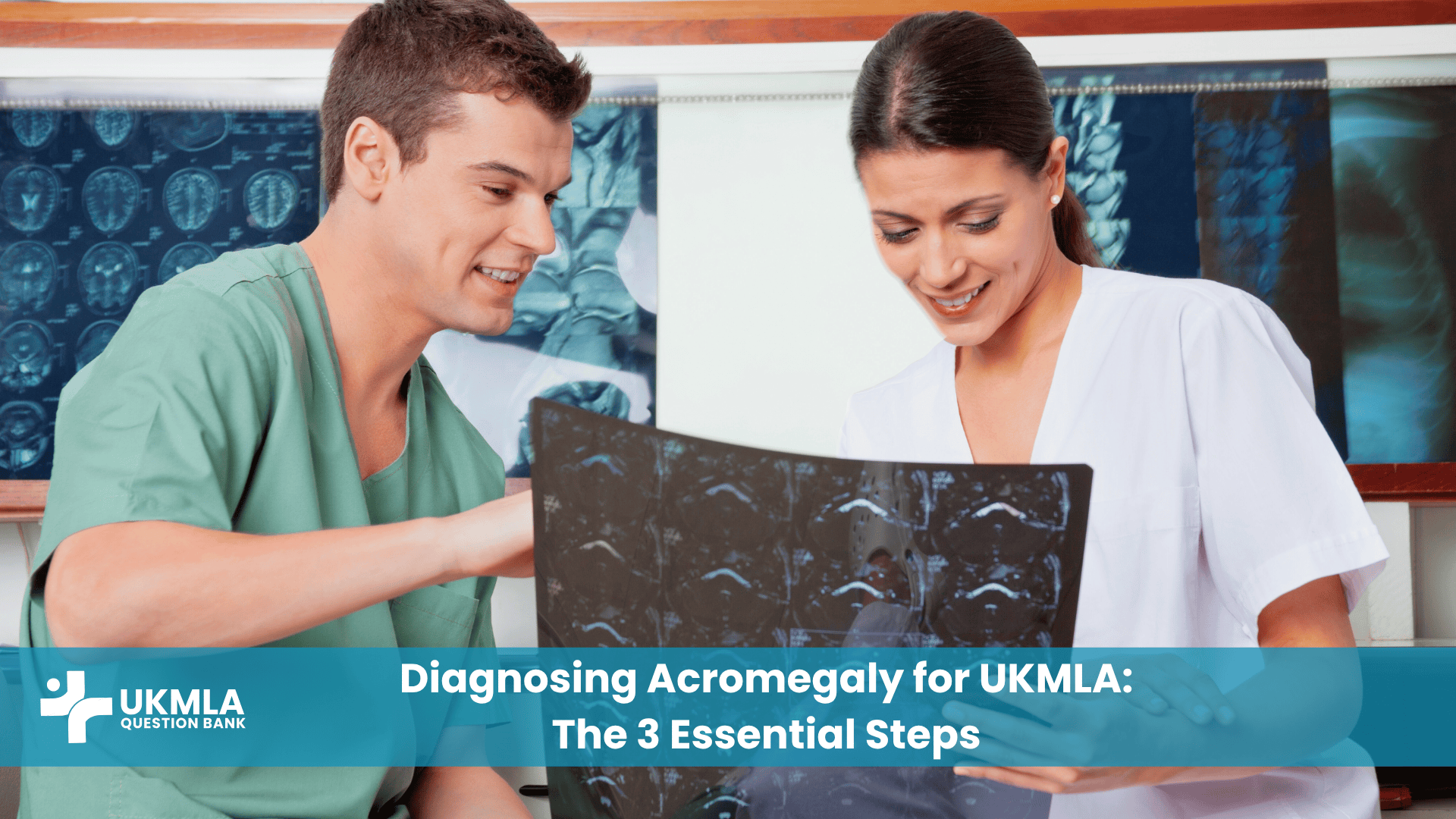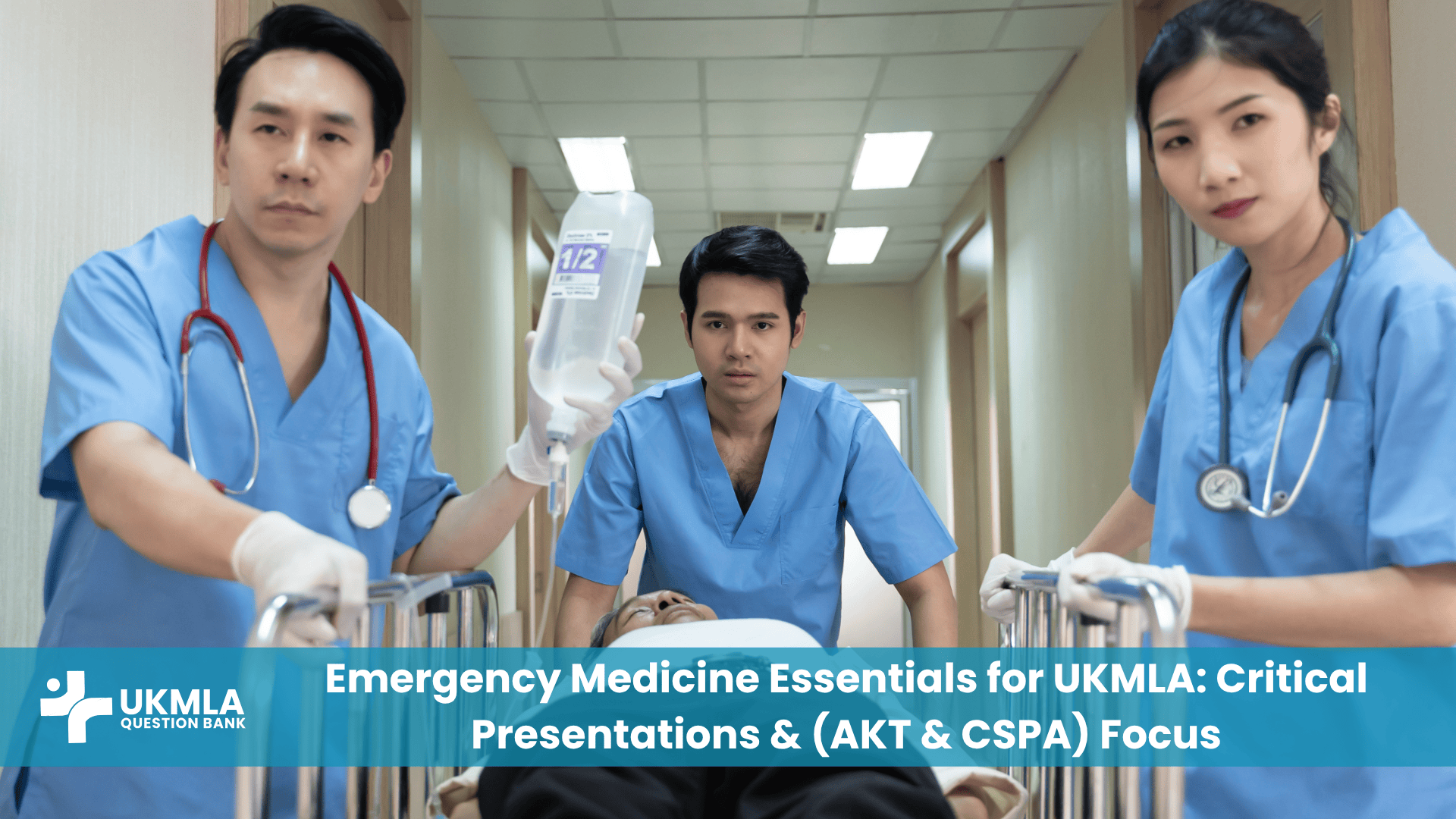Introduction
Mastering high-yield psychiatry for UKMLA is an essential part of preparing for the Applied Knowledge Test (AKT). Psychiatry is a core clinical area that tests more than just your knowledge of conditions; it assesses your understanding of communication, risk assessment, ethics, and the law. As a junior doctor, you will constantly manage patients with co-morbid mental health conditions, making these skills vital for safe and effective practice, regardless of your chosen specialty.
This guide is designed to be your essential roadmap to success. We will cut through the complexity to focus on the 7 key topics you are most likely to encounter in the exam. By understanding these core conditions and therapeutic approaches, you will build the confidence to deconstruct any psychiatry-based SBA (Single Best Answer) question and select the safest, most appropriate answer.
Table of Contents
ToggleThe 7 Key Topics for High-Yield Psychiatry for UKMLA
To succeed in this domain, you must structure your thinking. These seven key areas provide a framework that covers the vast majority of psychiatry questions you will face in the UKMLA AKT.
1. Mood Disorders (Depression & Bipolar Disorder)
Mood disorders are extremely common and a high-yield topic.
Depression: You must know the core symptoms: low mood, anhedonia (loss of interest or pleasure), and anergia (low energy). A crucial part of any assessment is a thorough risk assessment, specifically asking about thoughts of self-harm and suicide, intent, and plans. Management follows a stepwise approach, starting with low-intensity psychological interventions (like guided self-help) and moving to high-intensity therapies (like CBT) and/or antidepressant medication, with SSRIs (e.g., Sertraline) being the first-line choice. Be aware of treatment-resistant depression and the options for augmentation or switching antidepressants.
Bipolar Disorder: The key here is recognising the different phases of the illness. This includes episodes of depression, mania (persistently elevated mood, overactivity, reduced need for sleep, grandiose ideas, lasting at least one week), and hypomania (a milder form of mania without psychotic symptoms, lasting at least four days). The cornerstone of long-term management is mood stabilisers, such as Lithium, which requires careful monitoring (regular blood levels, U&Es, and TFTs) due to its narrow therapeutic index.
2. Psychotic Disorders (Schizophrenia & First Episode Psychosis)
Psychosis is a state where a person’s thoughts and perceptions are disturbed, and they may have difficulty recognising what is real.
Schizophrenia: You should be able to differentiate between positive symptoms (the presence of abnormal experiences, like auditory hallucinations, delusional beliefs, and thought disorder) and negative symptoms (the absence of normal experiences, like blunted affect, alogia, and avolition).
Management: The primary treatment is with atypical (second-generation) antipsychotics, such as Olanzapine, Risperidone, or Aripiprazole. It is vital to know their major side effects, including metabolic syndrome (weight gain, dyslipidaemia, diabetes) and extrapyramidal side effects (EPSEs). You should be able to recognise acute dystonia (painful muscle spasms, often treated with procyclidine) and tardive dyskinesia (late-onset involuntary movements). Be aware of the rare but life-threatening emergency of Neuroleptic Malignant Syndrome (NMS), which presents with fever, rigidity, and autonomic instability.
3. Anxiety Disorders (GAD, Panic Disorder, OCD)
While often grouped together, you need to be able to distinguish these common conditions.
Generalised Anxiety Disorder (GAD): This is characterised by excessive, uncontrollable worry about a number of different things, often accompanied by physical symptoms like restlessness and muscle tension. Management is a stepwise approach, similar to depression, involving psychological therapies (CBT) and medication (SSRIs).
Panic Disorder: This involves recurrent, unexpected panic attacks, which are sudden episodes of intense fear accompanied by physical symptoms like palpitations, sweating, and shortness of breath. The psychological principle of CBT here involves exposure to feared situations to break the cycle of avoidance.
Obsessive-Compulsive Disorder (OCD): This is characterised by obsessions (recurrent, intrusive thoughts) and compulsions (repetitive behaviours the person feels driven to perform). Management involves a specific form of CBT with exposure and response prevention (ERP) and/or high-dose SSRIs.
4. Substance Misuse
Questions on substance misuse will often focus on the recognition and management of withdrawal syndromes and their complications.
Alcohol Dependence: Be able to recognise the features of alcohol withdrawal, which can range from tremor and anxiety to seizures and delirium tremens (DTs) (characterised by confusion, agitation, and visual hallucinations). The management of severe alcohol withdrawal involves a reducing regimen of a long-acting benzodiazepine, such as Chlordiazepoxide or Diazepam, along with Pabrinex (IV vitamins) to prevent Wernicke’s encephalopathy (a triad of confusion, ataxia, and ophthalmoplegia).
Opioid Overdose: The classic triad is respiratory depression, pinpoint pupils, and reduced consciousness. The immediate, life-saving management is to secure the airway and administer the opioid antagonist, Naloxone.
5. Organic Psychiatry (Delirium & Dementia)
This area covers psychiatric symptoms caused by an underlying physical illness.
Delirium: This is an acute, fluctuating disturbance of consciousness and cognition. It is a medical emergency. The most important step in management is to identify and treat the underlying cause (the mnemonic PINCH ME can be helpful: Pain, Infection, Nutrition, Constipation, Hydration, Medication, Electrolytes).
Dementia: This is a chronic, progressive decline in cognitive function. You should be able to differentiate the main types.
Table 1: Differentiating Common Types of Dementia
| Dementia Type | Core Features | Key Differentiator |
|---|---|---|
| Alzheimer’s Disease | Insidious onset, progressive memory loss, later language and executive dysfunction. | Primarily a memory-led decline. |
| Vascular Dementia | Stepwise deterioration, often with focal neurological signs. Associated with cardiovascular risk factors. | The “stepwise” history is classic. |
| Lewy Body Dementia | Fluctuating cognition, visual hallucinations, and spontaneous parkinsonism. | The combination of cognitive decline with hallucinations and parkinsonism is key. |
6. Eating Disorders (Anorexia & Bulimia)
These are serious psychiatric illnesses with high physical morbidity and mortality.
Anorexia Nervosa: Characterised by a significantly low body weight (BMI < 17.5), an intense fear of gaining weight, and a distorted body image. You must be able to recognise the physical signs of starvation, such as emaciation, lanugo hair, bradycardia, hypotension, and electrolyte disturbances. Be aware of the risks of refeeding syndrome in severely malnourished patients.
Bulimia Nervosa: This involves a cycle of binge eating followed by compensatory behaviours (purging), such as self-induced vomiting or laxative abuse. Patients are typically of a normal weight or overweight. Key signs to look for include dental erosion, parotid gland swelling, and Russell’s sign (calluses on the knuckles).
7. Personality Disorders & The Mental Health Act
Personality Disorders: For the UKMLA, the main focus is on Emotionally Unstable Personality Disorder (EUPD), also known as Borderline Personality Disorder. This is characterised by unstable moods, relationships, and self-image, and is often associated with recurrent self-harm. Management is primarily psychological, with therapies like Dialectical Behaviour Therapy (DBT) being key.
The Mental Health Act (MHA): You need to understand the basic principles of when a patient can be detained (“sectioned”). This is generally when a person is suffering from a mental disorder of a nature or degree that warrants detention in hospital for assessment or treatment, and it is necessary for their own health or safety, or for the protection of other persons. Know the difference between Section 2 (for assessment, up to 28 days) and Section 3 (for treatment, up to 6 months). For more on the legal aspects, refer to our guide on Medical Ethics and Law for UKMLA.
Applying Psychiatric Principles to UKMLA Questions
Success in these SBA questions requires a specific approach.
A Note on Empathy: “Behind every psychiatric diagnosis is a person experiencing profound distress. The UKMLA will test your ability to respond not just with the correct medical answer, but with empathy, respect, and compassion. This is a core professional value.”
Risk Assessment is Always the First Step: In any scenario involving a patient with a mental health problem, your first thought should be: “Is this patient a risk to themselves or others?”. This will often guide you to the correct answer, which is frequently the safest option.
Navigating Capacity and Consent: Psychiatry questions often involve complex issues of consent. A patient may be refusing treatment, and you will need to assess their capacity to do so. The GMC’s guidance on “Decision making and consent” is the definitive UK document on this and is essential reading.
Frequently Asked Questions (FAQ): High-Yield Psychiatry for UKMLA
These are drug-induced movement disorders caused by antipsychotics blocking dopamine receptors. They include: acute dystonia (painful muscle spasms), akathisia (a sense of inner restlessness), parkinsonism (tremor, rigidity, bradykinesia), and tardive dyskinesia (late-onset, involuntary movements, often of the mouth and face).
A hallucination is a perception in the absence of an external stimulus (e.g., hearing a voice when no one is there). An illusion is a misinterpretation of a real external stimulus (e.g., seeing a shadow and thinking it’s a person).
Lithium has a narrow therapeutic index, so patients require regular blood tests to check their lithium level. Signs of toxicity include tremor, ataxia, confusion, and can progress to seizures and coma.
This is a potentially life-threatening condition caused by excessive serotonergic activity, often when two serotonergic drugs (like an SSRI and a triptan) are combined. The key features are a triad of autonomic instability (fever, tachycardia), neuromuscular hyperactivity (clonus, hyperreflexia), and altered mental state (agitation, confusion).
It is a simple, four-question screening tool for alcohol dependence: Have you ever felt you should Cut down? Have people Annoyed you by criticizing your drinking? Have you ever felt Guilty about your drinking? Have you ever had an Eye-opener (a drink first thing in the morning)?
A detained (“sectioned”) patient can be treated for their mental disorder against their will, if necessary. However, they still retain the right to refuse treatment for any physical health problems, provided they have the capacity to do so.
The key is the onset and course. Delirium is acute (hours to days), and the symptoms fluctuate throughout the day. Dementia is chronic (months to years), and the decline is progressive and more stable day-to-day.
The immediate priority is always to treat any physical injuries and ensure the patient is medically stable. A full psychosocial and risk assessment should follow once any life-threatening issues have been addressed.
They often focus on safety. You might be asked to identify the safest antidepressant for a patient with a history of heart disease, or to recognise the need for blood monitoring with drugs like lithium or clozapine. For more on this, our guide to high-yield pharmacology is a great
Understand the core features of the 7 key topics in this guide. Then, use a high-quality UKMLA question bank to practice applying this knowledge to clinical vignettes. Pay close attention to the risk assessment in every scenario.
Conclusion
Mastering high-yield psychiatry for UKMLA is about more than just learning diagnostic criteria. It’s about developing a systematic approach that prioritises patient safety, ethical principles, and empathetic communication. By structuring your revision around the 7 key topics in this guide, you can build a robust framework for understanding the core conditions and management strategies you will be tested on.
Remember to always begin with a risk assessment, consider the patient’s capacity, and apply your knowledge of both psychological and pharmacological therapies. This approach will not only help you excel in the AKT but will also prepare you for the real-world challenges of managing patients with mental health conditions.




